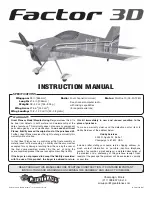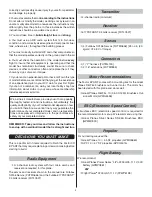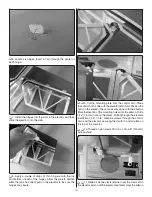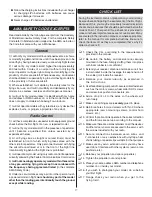
15
Set the Control Throws
Use a ruler to accurately measure and set the control throw
of each control surface as indicated in the chart that follows.
If your radio does not have dual rates, we recommend setting
the throws at the
low
rate setting.
NOTE
: The throws are measured at the
widest part
of the
elevators, rudder and ailerons.
These are the recommended control surface throws:
ELEVATOR
HIGH
LOW
1- 3/4"
[ 44 mm]
27°
1-1/4"
[32 mm]
19°
1"
[ 25 mm]
21°
5/8"
[16 mm]
13°
1-1/2"
[ 38 mm]
19°
1-1/4"
[ 32 mm]
16°
RUDDER
AILERONS
3D
2-1/4"
[ 57mm]
35°
1-1/4"
[ 32 mm]
27°
2-3/4"
[ 70 mm]
36°
Up & Down
Up & Down
Right & Left
We also put exponential into the High rates and the 3D rates to
make the control throws less sensitive around neutral. These
can be set up to your own preference and fl ying style. We put
20% to 30% in the high rate and 50% to 60% in the 3D rates.
IMPORTANT:
The Factor 3D EP has been
extensively
fl own
and tested to arrive at the throws at which it fl ies best. Flying
your model at these throws will provide you with the greatest
chance for successful fi rst fl ights. If, after you have become
accustomed to the way Factor 3D EP fl ies, you would like to
change the throws to suit your taste, that is fi ne. However,
too much control throw could make the model diffi cult to
control, so remember, “more is not always better.”
Finish the Model
❏
1. Insert a fl ight battery in the fuselage and use the hook
and loop material to hold the battery in position. Do not connect
the battery to the ESC while balancing the model.
❏
2. Install the propeller and spinner to the motor shaft.
Balance the Model (C.G.)
More than any other factor, the C.G. (center of gravity/
balance point) can have the greatest effect on how a model
fl ies and could determine whether or not your fi rst fl ight will
be successful. If you value your model and wish to enjoy it
for many fl ights,
DO NOT OVERLOOK THIS IMPORTANT
PROCEDURE.
A model that is not properly balanced may
be unstable and possibly unfl yable.
At this stage the model should be in ready-to-fl y condition with
all of the systems in place including the motor and battery,
landing gear, covering and paint, and the radio system.
❏
1. Use a felt-tip pen or 1/8" [3 mm]-wide tape to accurately
mark the C.G. on the top of the wing at the side of the fuselage.
The C.G. is located 4-1/4" [108 mm] back from the leading
edge of the wing at the side of the fuselage.
This is where your model should balance for the fi rst fl ights.
Later, you may wish to experiment by shifting the C.G. up
to 3/16" [ 5 mm] forward or 1/4" [ 6 mm] back to change
the fl ying characteristics. Moving the C.G. forward may
improve the smoothness and stability, but the model may
then require more speed for takeoff and make it more diffi cult
to slow for landing. Moving the C.G. aft makes the model
more maneuverable, but could also cause it to become too
diffi cult to control. In any case,
start at the recommended
balance point
and do not at any time balance the model
outside the specifi ed range.






































